Page 131 of 684
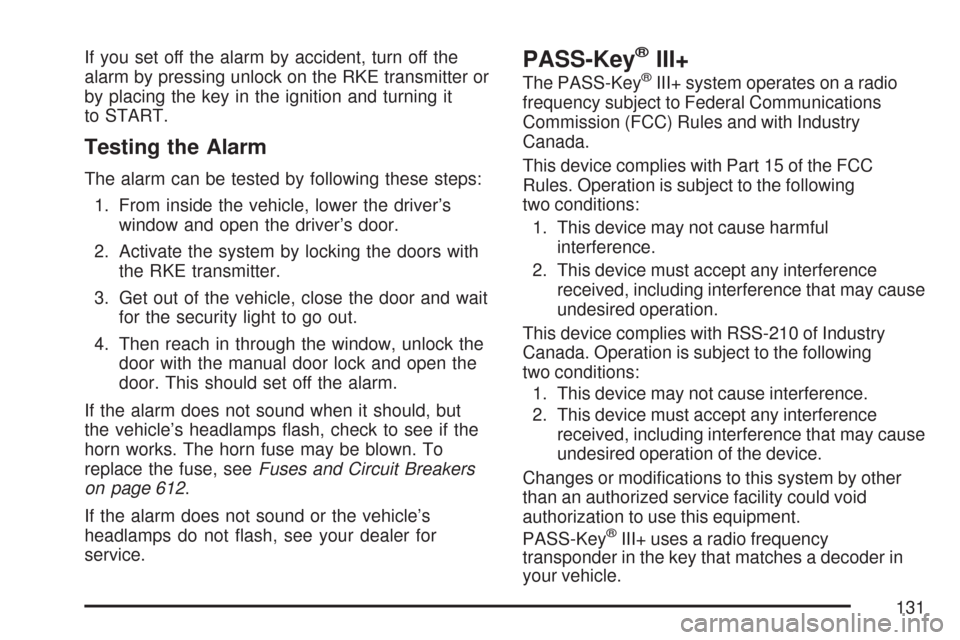
If you set off the alarm by accident, turn off the
alarm by pressing unlock on the RKE transmitter or
by placing the key in the ignition and turning it
to START.
Testing the Alarm
The alarm can be tested by following these steps:
1. From inside the vehicle, lower the driver’s
window and open the driver’s door.
2. Activate the system by locking the doors with
the RKE transmitter.
3. Get out of the vehicle, close the door and wait
for the security light to go out.
4. Then reach in through the window, unlock the
door with the manual door lock and open the
door. This should set off the alarm.
If the alarm does not sound when it should, but
the vehicle’s headlamps �ash, check to see if the
horn works. The horn fuse may be blown. To
replace the fuse, seeFuses and Circuit Breakers
on page 612.
If the alarm does not sound or the vehicle’s
headlamps do not �ash, see your dealer for
service.
PASS-Key®III+
The PASS-Key®III+ system operates on a radio
frequency subject to Federal Communications
Commission (FCC) Rules and with Industry
Canada.
This device complies with Part 15 of the FCC
Rules. Operation is subject to the following
two conditions:
1. This device may not cause harmful
interference.
2. This device must accept any interference
received, including interference that may cause
undesired operation.
This device complies with RSS-210 of Industry
Canada. Operation is subject to the following
two conditions:
1. This device may not cause interference.
2. This device must accept any interference
received, including interference that may cause
undesired operation of the device.
Changes or modi�cations to this system by other
than an authorized service facility could void
authorization to use this equipment.
PASS-Key
®III+ uses a radio frequency
transponder in the key that matches a decoder in
your vehicle.
131
Page 136 of 684
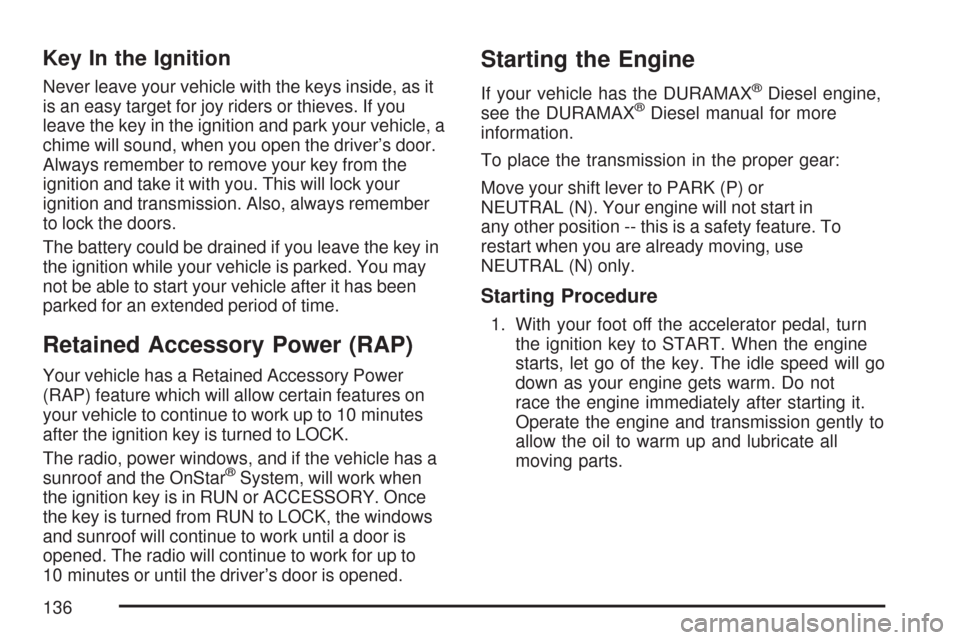
Key In the Ignition
Never leave your vehicle with the keys inside, as it
is an easy target for joy riders or thieves. If you
leave the key in the ignition and park your vehicle, a
chime will sound, when you open the driver’s door.
Always remember to remove your key from the
ignition and take it with you. This will lock your
ignition and transmission. Also, always remember
to lock the doors.
The battery could be drained if you leave the key in
the ignition while your vehicle is parked. You may
not be able to start your vehicle after it has been
parked for an extended period of time.
Retained Accessory Power (RAP)
Your vehicle has a Retained Accessory Power
(RAP) feature which will allow certain features on
your vehicle to continue to work up to 10 minutes
after the ignition key is turned to LOCK.
The radio, power windows, and if the vehicle has a
sunroof and the OnStar
®System, will work when
the ignition key is in RUN or ACCESSORY. Once
the key is turned from RUN to LOCK, the windows
and sunroof will continue to work until a door is
opened. The radio will continue to work for up to
10 minutes or until the driver’s door is opened.
Starting the Engine
If your vehicle has the DURAMAX®Diesel engine,
see the DURAMAX®Diesel manual for more
information.
To place the transmission in the proper gear:
Move your shift lever to PARK (P) or
NEUTRAL (N). Your engine will not start in
any other position -- this is a safety feature. To
restart when you are already moving, use
NEUTRAL (N) only.
Starting Procedure
1. With your foot off the accelerator pedal, turn
the ignition key to START. When the engine
starts, let go of the key. The idle speed will go
down as your engine gets warm. Do not
race the engine immediately after starting it.
Operate the engine and transmission gently to
allow the oil to warm up and lubricate all
moving parts.
136
Page 169 of 684
Engine Exhaust
{CAUTION:
Engine exhaust can kill. It contains the
gas carbon monoxide (CO), which you
cannot see or smell. It can cause
unconsciousness and death.
You might have exhaust coming in if:
The exhaust system sounds strange
or different.
Your vehicle gets rusty underneath.
Your vehicle was damaged in a
collision.
CAUTION: (Continued)
CAUTION: (Continued)
Your vehicle was damaged when
driving over high points on the road
or over road debris.
Repairs were not done correctly.
Your vehicle or the exhaust system
has been modi�ed improperly.
If you ever suspect exhaust is coming into
your vehicle:
Drive it only with all the windows
down to blow out any CO; and
Have your vehicle �xed immediately.
169
Page 173 of 684
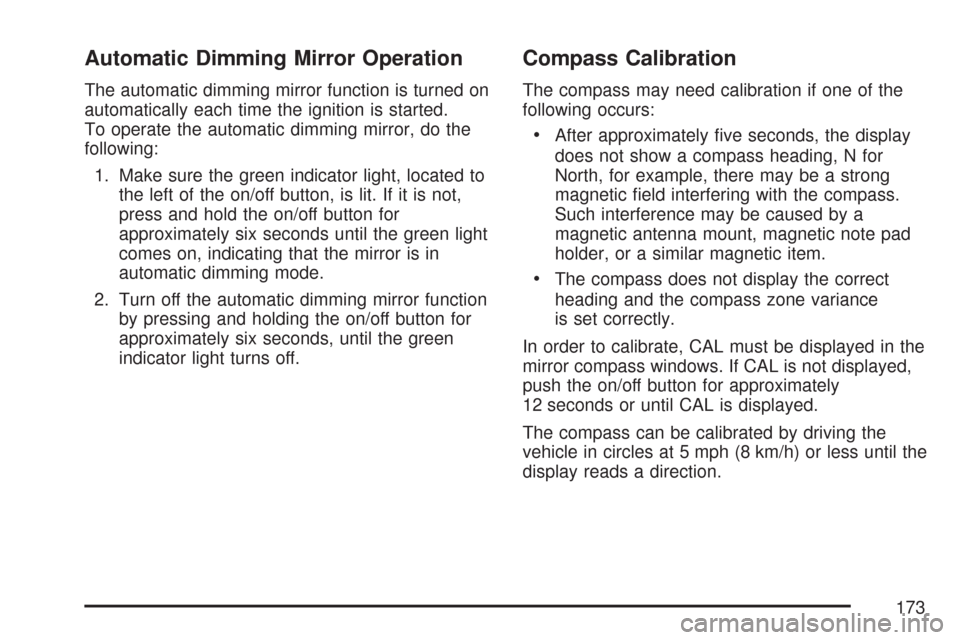
Automatic Dimming Mirror Operation
The automatic dimming mirror function is turned on
automatically each time the ignition is started.
To operate the automatic dimming mirror, do the
following:
1. Make sure the green indicator light, located to
the left of the on/off button, is lit. If it is not,
press and hold the on/off button for
approximately six seconds until the green light
comes on, indicating that the mirror is in
automatic dimming mode.
2. Turn off the automatic dimming mirror function
by pressing and holding the on/off button for
approximately six seconds, until the green
indicator light turns off.
Compass Calibration
The compass may need calibration if one of the
following occurs:
After approximately �ve seconds, the display
does not show a compass heading, N for
North, for example, there may be a strong
magnetic �eld interfering with the compass.
Such interference may be caused by a
magnetic antenna mount, magnetic note pad
holder, or a similar magnetic item.
The compass does not display the correct
heading and the compass zone variance
is set correctly.
In order to calibrate, CAL must be displayed in the
mirror compass windows. If CAL is not displayed,
push the on/off button for approximately
12 seconds or until CAL is displayed.
The compass can be calibrated by driving the
vehicle in circles at 5 mph (8 km/h) or less until the
display reads a direction.
173
Page 177 of 684
Outside Trailer-Tow Mirrors
If your vehicle has trailer towing type mirrors, they
can be adjusted so you can have a clear view
of the objects behind you. Manually pull out
the mirror head to extend it for better visibility
when towing a trailer.These mirrors can be manually folded forward or
rearward. The lower portion of the mirror is
convex. A convex mirror’s surface is curved so
you can see more from the driver’s seat. The
convex mirror can be adjusted manually to the
driver’s preferred position for better vision.
Your vehicle may have outside heated mirrors
which help clear them of condensation, snow, and
ice. When the rear window defogger button is
pressed, the heated mirrors are also turned on.
Only the upper glass of the mirror is heated.
The lower convex part of the mirror is not heated.
Your mirror may also have a turn signal arrow
that will �ash in the direction of the turn or
lane change.
177
Page 178 of 684
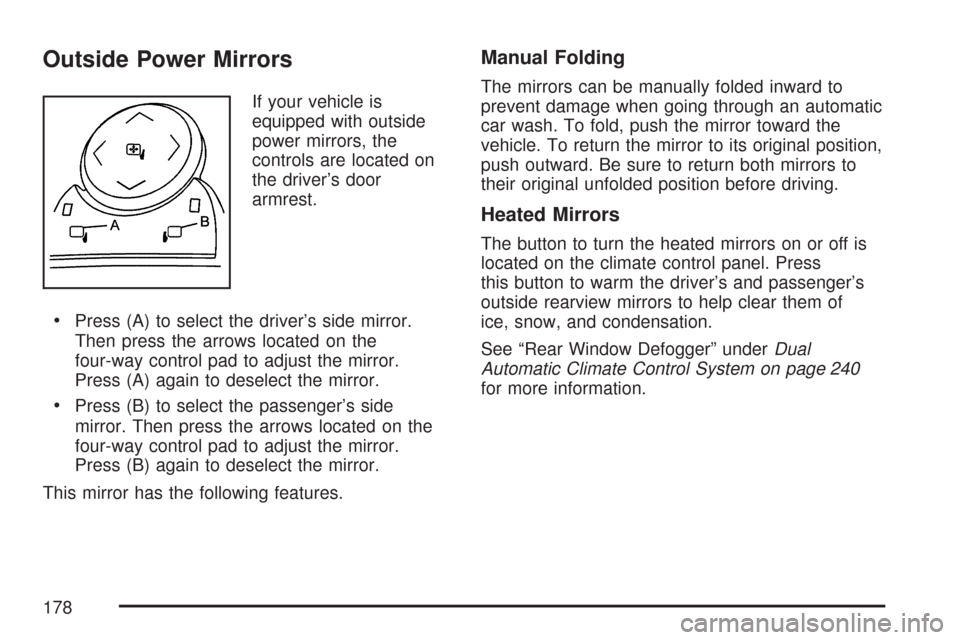
Outside Power Mirrors
If your vehicle is
equipped with outside
power mirrors, the
controls are located on
the driver’s door
armrest.
Press (A) to select the driver’s side mirror.
Then press the arrows located on the
four-way control pad to adjust the mirror.
Press (A) again to deselect the mirror.
Press (B) to select the passenger’s side
mirror. Then press the arrows located on the
four-way control pad to adjust the mirror.
Press (B) again to deselect the mirror.
This mirror has the following features.
Manual Folding
The mirrors can be manually folded inward to
prevent damage when going through an automatic
car wash. To fold, push the mirror toward the
vehicle. To return the mirror to its original position,
push outward. Be sure to return both mirrors to
their original unfolded position before driving.
Heated Mirrors
The button to turn the heated mirrors on or off is
located on the climate control panel. Press
this button to warm the driver’s and passenger’s
outside rearview mirrors to help clear them of
ice, snow, and condensation.
See “Rear Window Defogger” underDual
Automatic Climate Control System on page 240
for more information.
178
Page 181 of 684
Heated Mirrors
The button to turn the heated mirrors on or off is
located on the climate control panel. Press
this button to warm the driver’s and passenger’s
outside rearview mirrors to help clear them of
ice, snow, and condensation.
See “Rear Window Defogger” underDual
Automatic Climate Control System on page 240
for more information.
Convex Mirror
{CAUTION:
A convex mirror can make things (like
other vehicles) look farther away than
they really are. If you cut too sharply into
the right lane, you could hit a vehicle on
your right. Check your inside mirror or
glance over your shoulder before
changing lanes.
The passenger’s side mirror may have convex
glass. A convex mirror’s surface is curved so more
can be seen from the driver’s seat.
Your vehicle may also have a turn signal indicator
on the mirror. An arrow on the mirror will �ash
in the direction of the turn or lane change.
181
Page 219 of 684
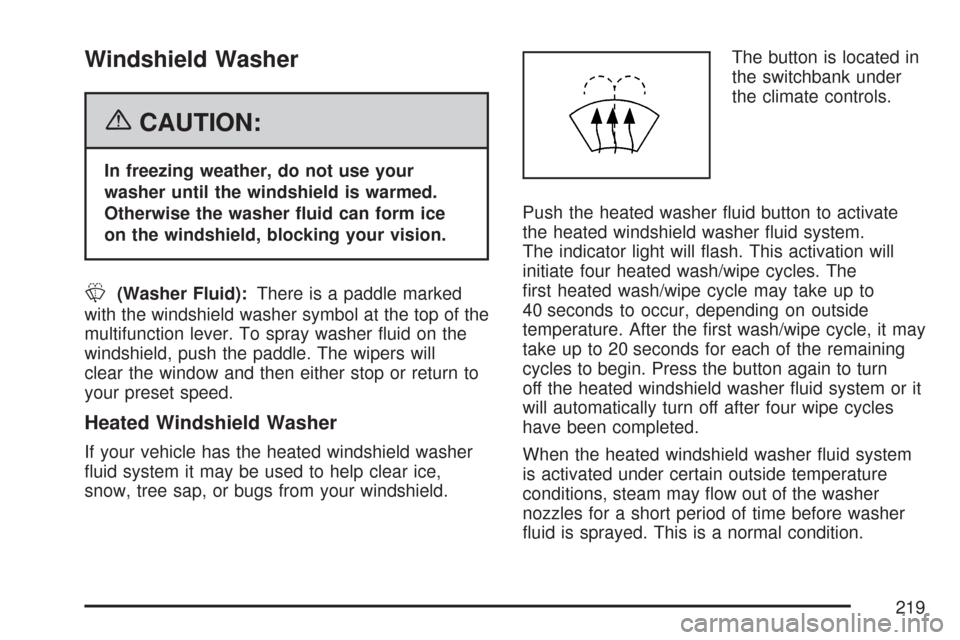
Windshield Washer
{CAUTION:
In freezing weather, do not use your
washer until the windshield is warmed.
Otherwise the washer �uid can form ice
on the windshield, blocking your vision.
L(Washer Fluid):There is a paddle marked
with the windshield washer symbol at the top of the
multifunction lever. To spray washer �uid on the
windshield, push the paddle. The wipers will
clear the window and then either stop or return to
your preset speed.
Heated Windshield Washer
If your vehicle has the heated windshield washer
�uid system it may be used to help clear ice,
snow, tree sap, or bugs from your windshield.The button is located in
the switchbank under
the climate controls.
Push the heated washer �uid button to activate
the heated windshield washer �uid system.
The indicator light will �ash. This activation will
initiate four heated wash/wipe cycles. The
�rst heated wash/wipe cycle may take up to
40 seconds to occur, depending on outside
temperature. After the �rst wash/wipe cycle, it may
take up to 20 seconds for each of the remaining
cycles to begin. Press the button again to turn
off the heated windshield washer �uid system or it
will automatically turn off after four wipe cycles
have been completed.
When the heated windshield washer �uid system
is activated under certain outside temperature
conditions, steam may �ow out of the washer
nozzles for a short period of time before washer
�uid is sprayed. This is a normal condition.
219